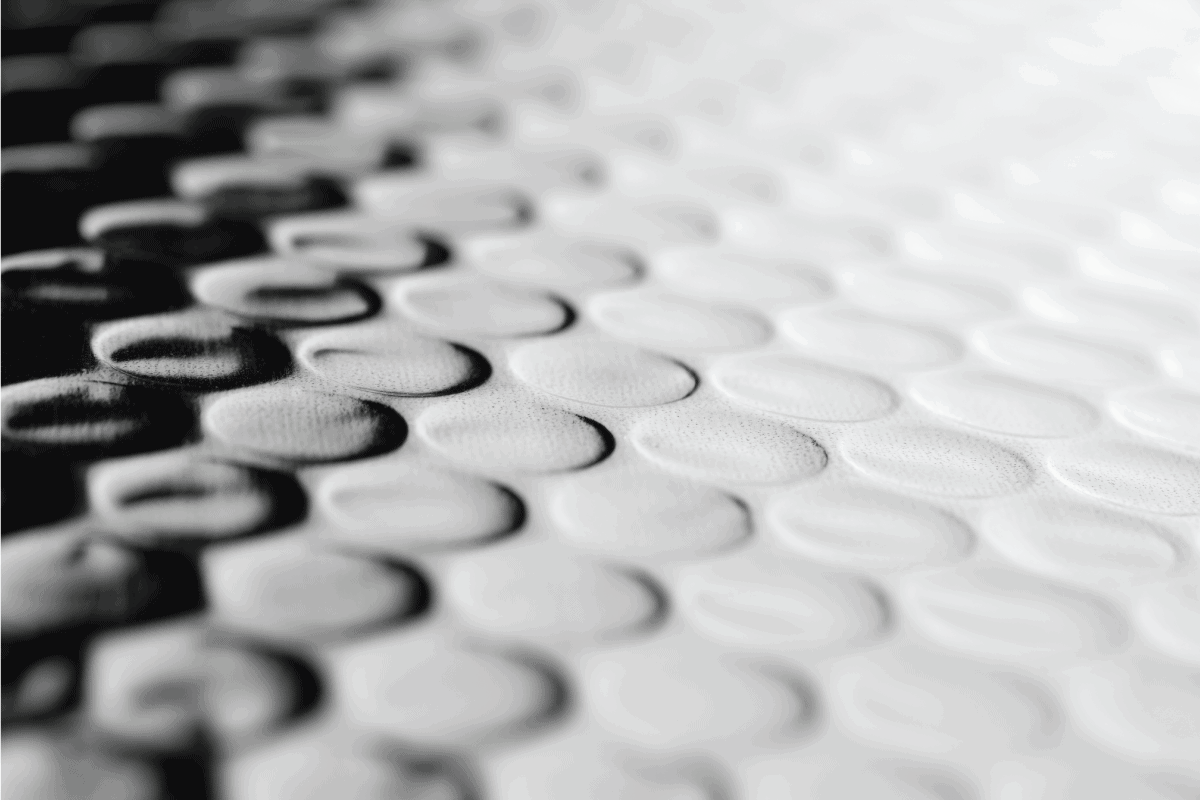Bubble wrap is a typical and available construction material that you can use to insulate a part of your house. Is it an effective insulator, and has it got the R-value required for insulation? Discover the correct recommendations from insulation experts.
The R-value or RSI-value of bubble wrap is 1.0 or 1.1, with a thickness of up to 3/8 inches. It is a suitable insulator for houses and commercial establishments. It also blocks heat transfer in attics, roofs, walls, and air-conditioning appliances using reflective foil.
Now that you learned the R-value of bubble wrap, it doesn't stop there; it can also save energy costs on your cooling system. Read on to discover more about bubble wrap insulations in different parts of your house and how to install them.
Bubble Wrap: Its R-Value And Insulation Qualities
The R-value of bubble wrap is low. R-value is an industrial term for heat resistance measured per unit area. The higher the number, the better the insulation material. Thus, it is not the insulation material you should look for for a massive or more serious insulation project.
Bubble wrap insulation can be a great supplement to a more performing insulator. But, it can be a stand-alone insulator in small spaces. The foil of bubble wraps contributes to fire protection.

Types Of Bubble Wrap
Bubble wrap has two types: single bubble foil and double bubble foil. The single bubble foil has only one layer of bubbles compared to the second type, which has two.
The double-bubble foil gives extra room for a couple of foil layers. Therefore, improving effectivity and minimizing more radiant heat transfer.
Single Bubble Foil
Single bubble foil is 1/8 to 3/16 in thickness, suitable for narrow spaces that need insulation. It serves as an affordable alternative for insulation. It is a replaceable, removable, and reusable temporary insulator.
Check out this single bubble reflective foil on Amazon.
Double Bubble Foil
Double bubble foil is 1/4 to 5/16 in thickness providing thick layers. It is recommendable for long-term installations. It is best to use when building a home and inserting some insulations. Of course, it insulates much better than the single bubble foil.
Check out this double bubble reflective foil on Amazon.
Advantages of Bubble Wrap Insulation
Although it has low heat resistance, bubble wrap boosts its performance with its advantages. Bubble wrap has many positive sides as an insulator. Read the list of bubble wrap insulation pros below:

- It maintains external heat outside during the hot season and preserves indoor heat during the freezing season.
- It is very light. Thus, trouble-free to carry and transport.
- It is uncomplicated to install.
- It reduces impact damage.
- It serves as soundproof.
- It traps moisture.
- It is recyclable and environment-friendly.
- It is cost-efficient and cheaper than other insulation materials.
Where To Use Bubble Wrap Insulation
Bubble wrap is desirable to use in small and large insulation projects. You can use both types of bubble wrap in different applications. Take note of the different situations where these bubble foils can fit and be efficient.
Single Bubble Foil
- Dog house
- Hot water tank
- Produce box
- DIYs
- Windshield guard
- Attic
- Car
- Building insulation
Double Foil
- Metal structure
- Pole barn
- Small homes
- Storage section
- Workroom
Tips For Installing Bubble Wrap Insulation
The bubble wrap is non-toxic. So, you don't need to wear any special protective gear or clothes during installation. Find out some tips for installing bubble wrap as insulators. Remember these points below:
- Gather the needed tools, such as cutting tools, a ladder, and a staple gun.
- Spread the needed size of insulation, making sure to show the shiny side.
- Use a sharp cutting tool such as a pair of scissors, a utility knife, or an electric cutter to make cutting easier. Though, bubble wrap comes in a roll that is easy to cut.
- You may add another insulation layer, such as spray foam, for better performance.
- Use the right size of the stapler to put in place the insulation for easy and continuous work. Staple it at about 200 to 300 mm. breaks.
- Use foil tape to seal any edges or tears after installation to achieve the maximum performance of the insulation.
Check out this foil tape on Amazon.
Other Uses Of Bubble Wraps
Using bubble wraps in different ways and not just for packaging or insulation is plausible. You will be surprised when you learn about other things you can do with it. Look at the list below to discover more uses of bubble wraps:
- It maintains the cool temperature of food.
- It works as an anti-shrink for your pairs of jeans.
- It works as a shaper for your shoes to help them last longer.
- It can work as a cushion in car seats and camp tents.
- It supports tree seedlings by wrapping them around the trunk.
- It protects tools to keep them in place and not scratch each other.
- It adds design to your food or artwork.
Will Bubble Wrap Insulate A Shed?
Bubble wrap can insulate a garden shed. It is a cheap option and is always available in the market. Cut the bubble wrap to the needed size to fit within the sides of the shed.
Moreover, the cut should fit every plain surface and the whole frame. Leave space for air to pass through to prevent dampness. Use a stapler to fasten the bubble wrap to the edge.
Will Bubble Wrap Insulate Pipes?
Yes. Wrap the bubble wrap around pipes to insulate. It is suitable for outdoor pipes in winter. It is a good alternative if you have run out of pipe insulators.
Have a look at this pipe wrap insulation on Amazon.
Does Bubble Wrap Insulate Windows?
Usually, you can use bubble wrap to insulate windows in greenhouses during winter. However, it works well in your windows; even without window shades, it works fine. You won't find it annoying when installing since it is flexible to any shape and curve.
Have a look at this large bubble roll on Amazon.
Is Bubble Wrap Insulation Flammable?
No. Bubble wrap comprises aluminum or metallic polyester and polyethylene, which is plastic. Thus, it is not flammable, nor can it cause a fire. These materials tend to melt in case of fire, contributing to the raging of the building.
Can You Use Bubble Wrap Under A Metal Roof?
You can utilize bubble wrap under a steel roof. It is a recommendable insulator for metal structures. Moreover, there is bubble wrap insulation specially designed for wall and roof installations. It helps you to have a stable indoor temperature during summer and winter.
Does Bubble Wrap Lose Air?
Yes, some bubble wraps lose air from the bubble. They have poor barrier film that causes shorter bubble life and early air loss in the holes. The bubbles come in different sizes. The most common sizes are six millimeters and one centimeter.
How Long Will Bubble Wrap Last?
The bubble wrap can last up to seven years as window insulation. As it gets older, it may stick to the glass. It is because it is losing its insulation ability. After about five years, it is advisable to replace bubble wrap insulation, especially in windows.
How Long Does Bubble Wrap Take To Decompose?
Bubble wrap takes around a thousand years to decompose when taken to a landfill like other plastic. Though, biodegradable versions are being made available in the market today, which take around 180 days to decompose. Pop the bubble wrap when recycling.
Is The Air In Bubble Wrap Toxic?
No, it's not. It is very tidy, and some use it as a test tube. It has no health hazard. Though, take extra precautions when burning it because it emits toxic fumes since it is plastic. Remember, plastic is petroleum-based.
![foil finish bubble wrap used as insulating material. What Is The R Value Of Bubble Wrap [Is It A Good Insulator]](https://hvacseer.com/wp-content/uploads/2022/09/foil-finish-bubble-wrap-used-as-insulating-material.-What-Is-The-R-Value-Of-Bubble-Wrap-Is-It-A-Good-Insulator.png)
Summing Up
Bubble wrap has a low R-value, meaning has poor thermal resistance. It has single and double bubble foil, making it more effective in maintaining indoor temperature in extreme weather. It is a good insulator for homes and commercial buildings.
Read more about bubble wrap insulation in these posts:
Should You Install Radiant Barrier In The Attic? Pros & Cons




